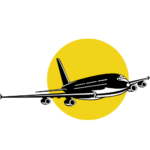Flying a plane might seem like magic to most of us, but behind the scenes, it’s a mix of science, skill, and rigorous training. One of the most important tools for teaching pilots these skills is the flight simulator. These high-tech machines have changed the way pilots learn, making flying safer and more precise. Let’s take a closer look at how flight simulators help train real pilots.
What is a Flight Simulator?
A flight simulator is a machine that mimics the experience of flying an aircraft. It can range from a simple computer program to a full cockpit with motion systems that move exactly like a real plane. Pilots can practice takeoffs, landings, and emergencies in a safe, controlled environment.
Think of it like a video game—but one that can save lives. Unlike video games, flight simulators are highly realistic, often replicating real weather, physics, and aircraft behavior.
Why Pilots Use Flight Simulators
Pilots use simulators because they are safer, cheaper, and more effective than training exclusively in real planes. Here’s why:
-
Safety First 🛑: Simulators allow pilots to experience dangerous situations like engine failure or severe turbulence without risking lives.
-
Cost-Effective 💸: Operating a real plane for training is expensive. Simulators save fuel, maintenance, and wear-and-tear costs.
-
Repetition for Mastery 🔄: Pilots can repeat maneuvers as many times as needed until they perfect them.
-
Immediate Feedback 📊: Simulators provide instant feedback, helping pilots learn faster.
Different Types of Flight Simulators
Not all simulators are created equal. They vary in complexity and realism. Here’s a simple breakdown:
| Type | Description | Uses |
|---|---|---|
| Desktop Simulators | Basic software with controls connected to a computer. | Initial training, learning procedures, practicing navigation. |
| Full Flight Simulators (FFS) | Full-scale cockpit with motion systems, realistic visuals, and sound. | Advanced pilot training, emergency procedures, instrument flight rules (IFR) practice. |
| Fixed-Base Simulators | Cockpit without motion, but realistic controls and visuals. | Procedural training, instrument practice, and coordination exercises. |
How Flight Simulators Train Pilots
Learning Aircraft Controls
When pilots first start, they need to understand how the aircraft responds to their inputs. In a simulator, they can practice:
-
Adjusting throttle and pitch
-
Using rudder and ailerons
-
Managing flaps and landing gear
Because the simulator replicates the real plane’s behavior, this hands-on practice builds muscle memory safely.
Practicing Emergency Situations
One of the biggest advantages of simulators is emergency training. Pilots can practice rare but critical scenarios such as:
-
Engine failures
-
Bird strikes
-
Severe weather conditions
-
Instrument failures
Experiencing these situations in a simulator prepares pilots to react calmly and correctly in real life.
Learning Instrument Flight Rules (IFR)
Pilots often fly in clouds or low visibility, where they can’t rely on sight. IFR training teaches pilots to navigate using instruments alone. Simulators provide:
-
Accurate cockpit instruments
-
Realistic weather conditions
-
GPS and navigation systems
Scenario-Based Training
Modern simulators allow instructors to create specific scenarios. For example, a pilot can practice landing on a short runway during a storm or performing a go-around when the approach is unsafe. These scenarios train decision-making, problem-solving, and situational awareness.
Why Simulators Make Training Safer and Smarter
Before simulators existed, pilots had to learn some dangerous maneuvers in real planes. Today, they can:
-
Reduce accidents: Mistakes in a simulator don’t cause harm.
-
Gain confidence: Repeated practice builds skill and calmness.
-
Save resources: Planes, fuel, and instructors’ time are preserved.
The Role of Motion and Visuals
High-end simulators include motion systems and realistic visuals. This is not just for fun—it helps pilots:
-
Feel acceleration and turns
-
Judge altitude and distance
-
React to turbulence
These systems trick the brain into thinking it’s flying, improving real-world performance.
Benefits for Experienced Pilots
Even seasoned pilots use simulators to maintain skills and get certified for new aircraft. They can practice:
-
Handling new aircraft models
-
Updating knowledge of regulations and procedures
-
Perfecting tricky maneuvers before flying a real plane
Table: Simulator Training vs Real Flight Training
| Feature | Simulator | Real Plane |
|---|---|---|
| Safety | Very high | Moderate risk |
| Cost | Low | Very high |
| Repetition | Unlimited | Limited |
| Emergency Practice | Safe and repeatable | Risky, limited |
| Weather Simulation | Instant and variable | Real-time only |
The Future of Flight Simulators
Technology is advancing fast. Modern simulators now include:
-
Virtual reality (VR) integration for more immersive experience
-
Artificial intelligence (AI) instructors that adapt scenarios
-
Cloud-based simulators for remote training
These advancements make pilot training faster, more effective, and accessible worldwide.
FAQs About Flight Simulators
Q1: Can a simulator really teach you how to fly a plane?
Absolutely! Simulators teach all essential skills—control, navigation, emergency response, and decision-making. They are used by professional airlines for official pilot training.
Q2: Do pilots spend most of their training in simulators?
Training is split. Beginners start in simulators, then progress to real aircraft. Experienced pilots also use simulators for ongoing skill maintenance.
Q3: Are flight simulators expensive?
High-end simulators can cost millions, but they are far cheaper than flying a real plane continuously. Desktop simulators are much more affordable and still useful for initial training.
Q4: Do simulators feel real?
Yes! Full-flight simulators with motion systems replicate the feel, sound, and visuals of a real aircraft almost perfectly.
Q5: Can you get a pilot license using only a simulator?
No, real flight hours are required for licensing. However, simulator hours count toward training and reduce risks during actual flights.
Conclusion
Flight simulators are the unsung heroes of aviation. They turn nervous beginners into skilled pilots and keep professionals sharp. By providing a safe, cost-effective, and realistic training environment, simulators save lives, money, and resources. The next time you see a pilot confidently landing a plane during a storm, remember—they probably practiced that scenario hundreds of times in a simulator first. 🛫✨

